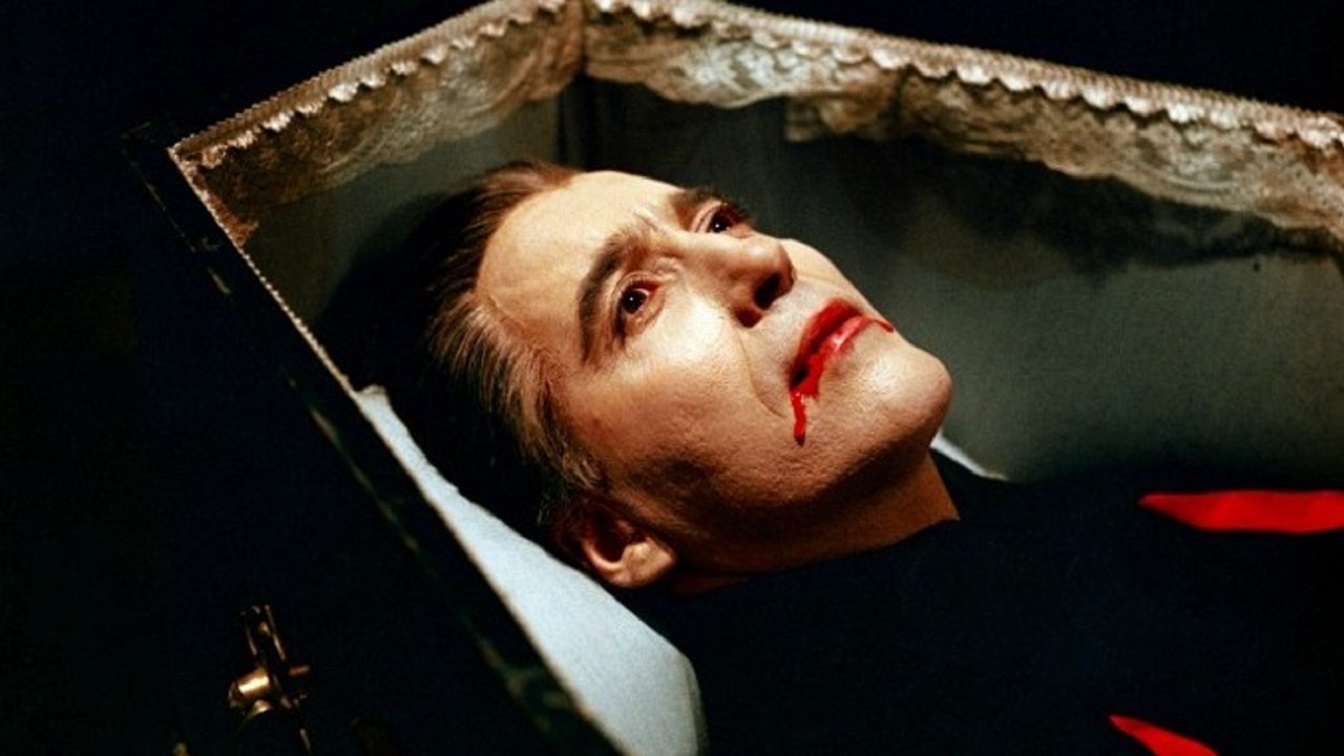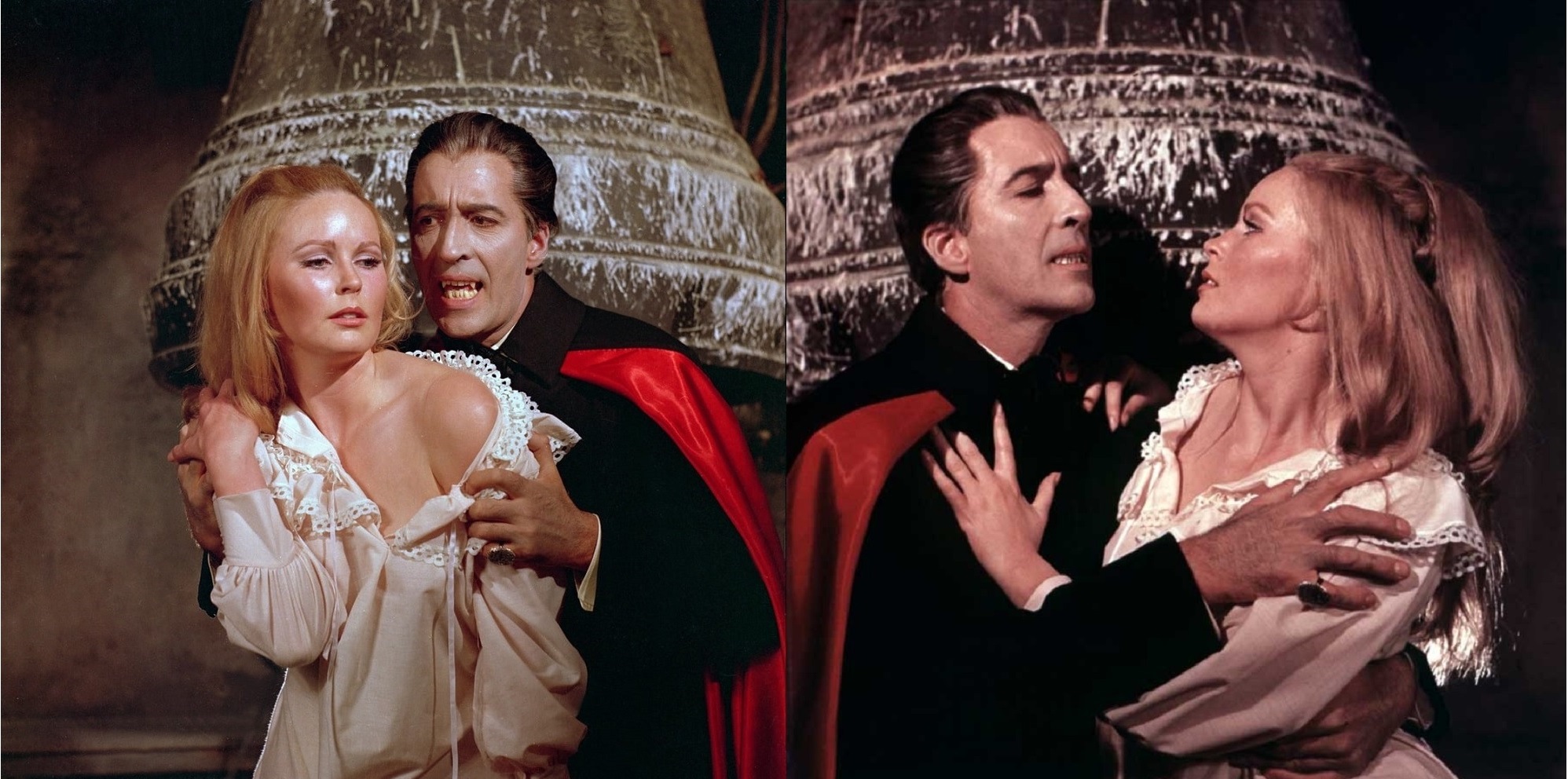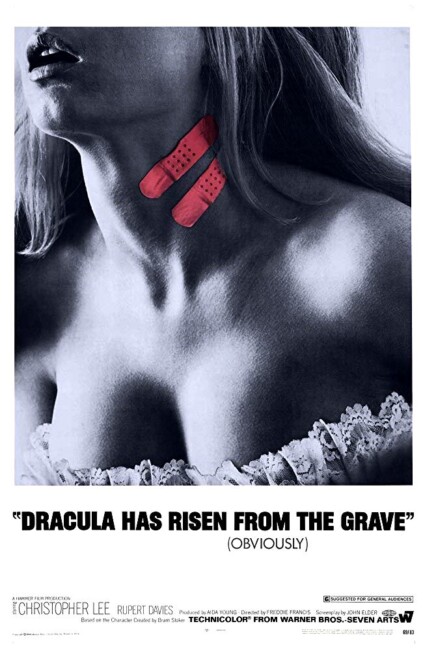UK. 1968.
Crew
Director – Freddie Francis, Screenplay – John Elder [Anthony Hinds], Producer – Aida Young, Photography – Arthur Grant, Music – James Bernard, Special Effects – Frank George, Makeup – Heather Nurse & Rosemary McDonald Peattie, Art Direction – Bernard Robinson. Production Company – Hammer.
Cast
Christopher Lee (Count Dracula), Barry Andrews (Paul), Rupert Davies (Monsignor Ernst Muller), Veronica Carlson (Maria), Barbara Ewing (Zena), Ewan Hooper (Priest), Michael Ripper (Max)
Plot
A visiting Monsignor comes to the town beneath Castle Dracula. He is disgusted to find that even after Dracula has been killed, the town still lives in such fear that the church is empty on Sunday morning. He drags the cowardly priest up the mountainside to Castle Dracula where they perform a rite of exorcism and he places a cross over the entrance to the castle. The priest then falls and hits his head. The blood drips down and revives Dracula where he is imprisoned inside a frozen mountain stream. Enraged at what the Monsignor having exorcised his castle, Dracula follows him to his home town and plans revenge by turning his niece Maria into a vampire.
Dracula Has Risen from the Grave was the fourth of the Hammer Dracula films. The first in the series Dracula/The Horror of Dracula (1958) had made the Hammer name and birthed an entire English horror industry. Subsequently, Hammer had spun out the excellent The Brides of Dracula (1960), although this was without Christopher Lee who was trying to avoid typecasting. Hammer subsequently brought Lee back for Dracula – Prince of Darkness (1966). By the time of Dracula Has Risen from the Grave, Christopher Lee was firmly established in the role, although original director Terence Fisher, who had helmed the preceding three entries, had bowed out of the series and the reins were here inherited by Freddie Francis, who had similarly stepped into Fisher’s shoes on Hammer’s Frankenstein series with The Evil of Frankenstein (1964). (See below for Freddie Francis’s other genre films).
Dracula Has Risen from the Grave is one of the entries made before a creative drought started to enter Hammer’s Dracula series and is an occasion where all parties involved turn out on good form. Certainly, there is an undeniable silliness to the plot. Screenwriter John Elder introduces some spurious business about Dracula being able to pull a stake out of his heart unless it is hammered in by somebody with faith. One also wonders why Dracula is unable to simply get the priest that he puts under his control to remove the cross barring the door of his castle in the first place.

And there is the petty revenge plot – in all their Dracula sequels, Hammer could never find much for Dracula to do so had to keep inventing things like these petty revenge plots to keep him busy – somehow revenge seems something that would be beneath Dracula. Christopher Lee, as usual, is not given much to do other than stand around, look evil and let his eyes turn red. Nevertheless, the script provides for some effective characterisation, creating an interesting debate between atheism and belief.
In his only entry in the Hammer Dracula series, Freddie Francis, one of the more underrated directors in the Anglo-Horror cycle, directs effectively. There is some silly business framing the edges of the lens in sepia tone. However, Francis does give a surprising sexual element to the film – watch how perennial Hammer heroine Veronica Carlson opens her dress and passively awaits Christopher Lee’s arrival, or how Barbara Ewing (giving a spirited performance as a barmaid) pleads him to drink her blood instead of chasing after Veronica Carlson.
The sets are particularly good – the exception being the frontispiece of the castle that looks like it is made of cardboard. Especially good are the rooftop sets, which are designed with a feel almost right out of The Cabinet of Dr Caligari (1919) with jagged, angular chimneys, boiling fogs and all lit virtually in monochrome. In fact, Dracula Has Risen from the Grave is almost the antithesis of Terence Fisher’s approach – Fisher’s sets are florid and sumptuously colourful, while Freddie Francis likes them washed out and stripped of all vividity to stark, neutral colours. It makes for quite an interesting contrast.

Hammer’s other Dracula films are:– Dracula/The Horror of Dracula (1958), The Brides of Dracula (1960), Dracula – Prince of Darkness (1966), Taste the Blood of Dracula (1970), Scars of Dracula (1971), Dracula A.D. 1972 (1972), The Satanic Rites of Dracula/Count Dracula and His Vampire Bride (1973) and The Legend of the 7 Golden Vampires/The Seven Brothers Meet Dracula (1974).
Freddie Francis’s other genre films are:- Vengeance/The Brain (1962), Paranoiac (1963), The Evil of Frankenstein (1964), Nightmare (1964), Dr Terror’s House of Horrors (1965), Hysteria (1965), The Skull (1965), The Psychopath (1966), The Deadly Bees (1967), They Came from Beyond Space (1967), Torture Garden (1967), Mumsy, Nanny, Sonny & Girly (1969), Trog (1970), The Vampire Happening (1971), Tales from the Crypt (1972), Craze (1973), The Creeping Flesh (1973), Tales That Witness Madness (1973), Legend of the Werewolf (1974), Son of Dracula (1974), The Ghoul (1975), The Doctor and the Devils (1985) and Dark Tower (1987).
Trailer here


